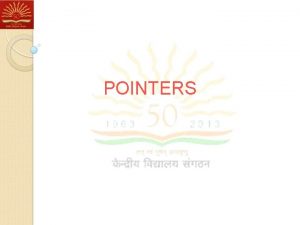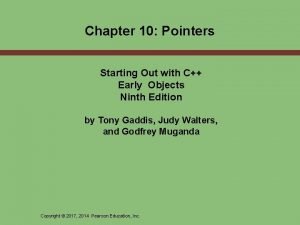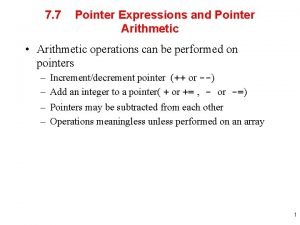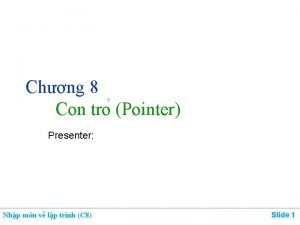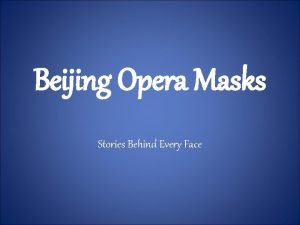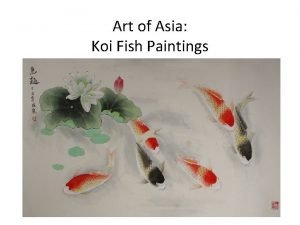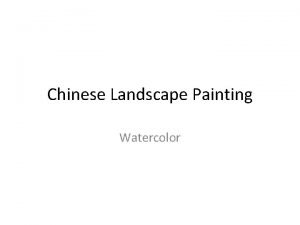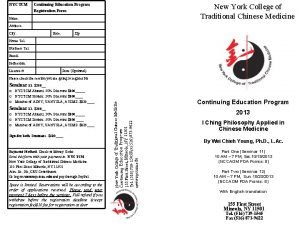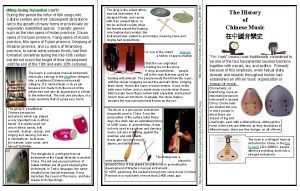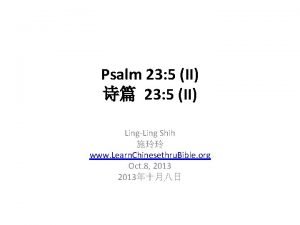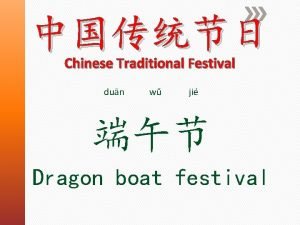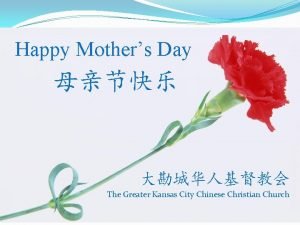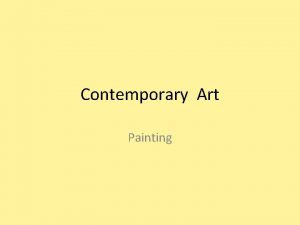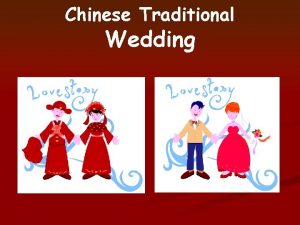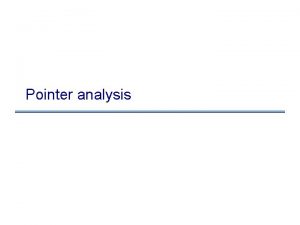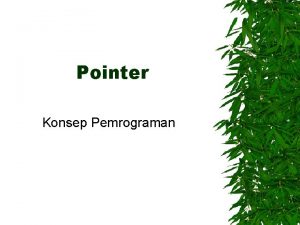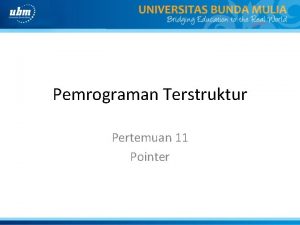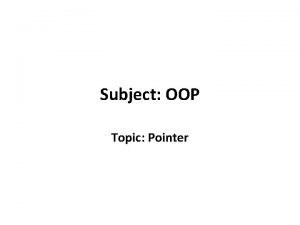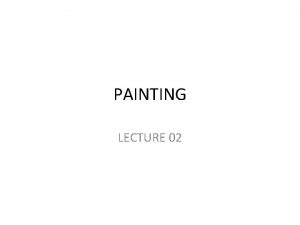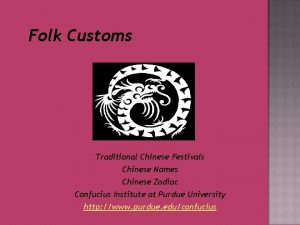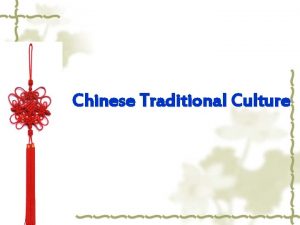ART OF CHINA CHINESE TRADITIONAL PAINTING Madison Pointer
















- Slides: 16

ART OF CHINA: CHINESE TRADITIONAL PAINTING Madison Pointer

THE THREE PERFECTIONS Poetry Painting Calligraphy Traditionally, these were created using …

THE FOUR TREASURES The most valued possessions of the Chinese artist and scholar were: Brush (bi) Ink (mo) Inkstone (yan) Paper (Xuan zhi) These materials symbolized one’s high status in society, and were owned by the educated, scholars and government officials

TOOLS OF THE TRADE Inks Traditional inks are made from sticks of solid ink Using a mixing stone, the artist adds a little water, then rubs the solid ink on the ink stone until the desired amount of ink has been released An almost unlimited range of hues and intensities can be created

TOOLS OF THE TRADE Brushes Come in a variety of sizes Sold in sets of varying sizes to ensure a calligrapher will have a brush size suited to his writing purpose Usually have bamboo handles with sheep or pony hair bristles

TOOLS OF THE TRADE Papers Rice paper or paper made from bamboo, bamboo itself, hemp, rice and wheat The most desirable Chinese calligraphy paper is made from tartar wingceltis in Anhuei province

TECHNIQUES Hand Position The wrist is bent The palm is cupped The brush is held between the thumb and the index and middle fingers with stabilization provided by the ring finger The pinky does not touch the brush The brush is held vertically and perpendicular to the paper The entire arm moves, creating strokes and styles unique to each calligrapher

TECHNIQUES Stroke Order Exact dictionary correct stroke order must be followed Still results in individually unique characteristics for the artwork

USE OF SPACE IN PAINTING “Positive space” - the area filled by a shape or subject such as a figure “Negative space” - the empty area that surrounds the positive space In Chinese landscapes, large areas of negative space are often left unpainted on purpose, like: air water mist clouds In Taoist philosophy, this balance of space is an expression of yin and yang, as well as an artistic technique like the rule of thirds in photography.

SYMBOLISM Bamboo - virtue, perseverance in the face of adversity, and friendship Dragon - imperial power, strength, and protection Landscape (shanshui) Literally “mountain-water” - microcosm of the universe; capable of emitting the purest form of qi or “energy” Lotus - fertility, sacredness, and perfection. In Buddhism, it also represents individuals who search for enlightenment Monkey – represents human-like qualities, like playfulness and compassion Peach - long life because it is believed that individuals who eat this fruit will remain youthful. Pine - longevity and loyalty because it stays evergreen Plum blossom - endurance and friendship because it survives the

FAMOUS ARTISTS OF THE TIME Hsu Hsi - Southern T'ang Dynasty (937 -975) The Jade Hall Peony ink and colors on silk • from Nanking • famous for his "drawings from life" and his use of color • usually painted flowers, bamboo, rocks, birds, and fish as seen in nature • this painting is typical of a class of Five Dynasties court painting that emphasized realism

FAMOUS ARTISTS OF THE TIME Ch'en Shu - (1660 -1736), Qing Dynasty • native of Hsiu-shui in Chekiang Province • noted for her paintings of flowers, birds, insects and grasses and landscapes • this scroll was painted when she was 75 years old! New Year's Day (1735)

FAMOUS ARTISTS OF THE TIME Chin T'ingpiao - (18 th century), Qing Dynasty • from Wu-hsing, Chekiang • famous for portrait, figure and flower paintings • this painting illustrates the story of Pan Chao, who was the first woman historian of China Ts'ao Taku Writing the Han Documents - ink and colors on paper

FAMOUS ARTISTS OF THE TIME Tung Panta - (1699 -1769), Qing Dynasty • native of Fuyang in Chekiang Province • famous for his use of colors • President of the Board of Rites (li-pu), which managed the acceptance of foreign representatives like an embassy as well as religious issues and administer government exams • this painting is an example of his landscapes, which followed the styles Kingfisher-blue Rocks and Red Trees of the Yuan masters - ink and color on paper

FAMOUS ARTISTS OF THE TIME Huang Chu Tsai - Sung Dynasty • from Dh'engtu in Szechuan Province • son of famous Huang Ch'uan and carried his father's style in bamboo, birds, rocks and landscape • his paintings were the standard by which early Sung academic paintings were judged Wild Geese and Rushes - ink and colors on silk

SITES VISITED http: //www. asia-art. net/ancient 1. htm http: //www. chinesecalligraphysets. com/chinese-calligraphy-brushsets. html http: //sln. fi. edu/tfi/info/current/inventions. html http: //www. masterwu. net/Master. Wu. Calligraphy. html http: //www. kwintessential. co. uk/articles/china/ancient-chineseart/1736 http: //www. learnnc. org/lp/editions/mandarin 1/4539
 Constant pointer and pointer to constant
Constant pointer and pointer to constant Pointer of pointer in c
Pointer of pointer in c Constant pointer and pointer to constant
Constant pointer and pointer to constant Pointer constant in c
Pointer constant in c Constant pointer and pointer to constant
Constant pointer and pointer to constant Pointer expressions
Pointer expressions Pointer pointer
Pointer pointer Pointer pointer
Pointer pointer Signifies fierceness ambition and cool headedness
Signifies fierceness ambition and cool headedness Coy fish paintings
Coy fish paintings Primary 3 malay worksheets
Primary 3 malay worksheets It involves the same techniques as in traditional painting
It involves the same techniques as in traditional painting 纽约中医学院
纽约中医学院 China percussion instruments
China percussion instruments Psalm 23 in chinese (traditional)
Psalm 23 in chinese (traditional) Chinese traditional festival
Chinese traditional festival Happy mother day chinese
Happy mother day chinese

